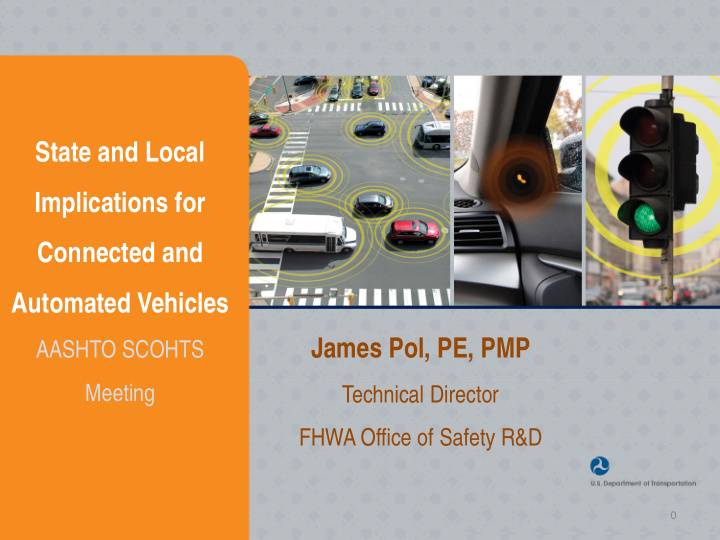



State and Local Implications for Connected and Automated Vehicles James Pol, PE, PMP AASHTO SCOHTS Meeting Technical Director FHWA Office of Safety R&D 0
Agenda • USDOT ITS Strategic Plan 2015-2019 • Connected Vehicles & Safety Benefits • Automated Vehicles • Community Response to Connected Vehicles • FHWA Connected Vehicle Deployment Guidance • Connected Vehicle Applications & Pilots 1
2
Congestion Today 3
Congestion Tomorrow 4
Limits on Creating New Capacity Source: http://www.dot.gov/BeyondTraffic 5
Kate Hartman ITS Strategic Plan 2015-2019 U.S. Department of Transportation 6 ITS Joint Program Office
Vision and Mission VISION Transform the Way Society Moves MISSION Conduct research, development, and education activities to facilitate the adoption of information and communication technology to enable society to move more safely and efficiently. 7
Innovation Through Connectivity: Connected Vehicles Connected vehicles are the future of transportation: Connected vehicles can save lives by significantly • reducing traffic accidents Connected vehicles can make travel easier, more • efficient, and more enjoyable Connected vehicles can help curb pollution • Connected vehicles include all modes of transportation • as well as pedestrians Connected vehicle research is a partnership between • the USDOT, the auto industry, and other public and private researchers Connected vehicles are not a threat to your privacy • 8
Program Category: Connected Vehicles 9
Safety Benefits of Connected Vehicles NHTSA studied the safety benefits of two V2V applications: Intersection Movement Assist (IMA) and • Left Turn Assist (LTA). IMA : Warns the LTA: Notifies a driver when it is driver who is not safe to enter attempting to an make a left turn intersection— with oncoming for example, traffic that it is not when something safe to proceed is blocking the driver’s view of opposing or crossing traffic NHTSA estimates that IMA and LTA would potentially prevent up to 592,000 crashes and save up to • 1,083 lives annually. 10
Innovation Through Automation: Automated Vehicles The path toward connected vehicles will ultimately lead to automated vehicles. 11
Automation In Transportation Full automation has the potential to • revolutionize the transportation system but requires careful study Partial automation will likely provide • significant transportation system benefits Connectivity is critical to safe and efficient • operations 12
Community Responses to Connected Vehicles • “The focus for connected vehicles should be in making a dramatic improvement in road safety…by the application of systems engineering to the four contributing domains: – road design and traffic control systems; – vehicle design and networking; – information and communications technology applied to road traffic safety; and – human systems integration optimization. Source: IdeaScale Response to ITS Strategic Plan 2015-2019 13
Deployment is Coming • V2V auto industry deployments moving forward • NHTSA announcement about regulatory proposal that would require V2V in new vehicles • V2I prototype deployment testing nearing completion • Ongoing supporting research such as AASHTO Footprint Analysis and Pooled Fund Studies Source: http://www.its.dot.gov/presentations/worldcongress2014/PDF/V2I_Deployment_Guidance_Arnold.pdf 14
How Do You Prepare? • Infrastructure will be deployed and operated by State and local DOT’s – Not a “shall” – Use of V2I is not mandated – But, you need to know about planning, funding, deployment, etc. • What investments could be made to leverage a nationwide fleet of equipped vehicles in support of state and local policy and operational objectives? Source: http://www.its.dot.gov/presentations/worldcongress2014/PDF/V2I_Deployment_Guidance_Arnold.pdf 15
2015 FHWA V2I Deployment Guidance http://www.its.dot.gov/meetings/pdf/V2I_Depl oymentGuidanceDraftv9.pdf 16
Topics Covered in the Draft Guidance Planning Use on public sector fleets • • Federal-aid Eligibility Procurement processes • • V2I Deployments and NEPA Legacy systems/devices • • Interoperability Communication technology • • Evaluation DSRC Service Licensing • • ITS Equipment Capability and Data Connection and Latency • • Compatibility Connected Vehicle Privacy • Hardware/Software Certification Principles • Reliability Connected Vehicle Security • • Use of Right of Way Data Access • • Allowance of Private Sector Use Manual on Uniform Traffic • • Control Devices Design consideration for facilities • Using Public-Private Partnerships Use of existing infrastructure • • Source: http://www.its.dot.gov/presentations/worldcongress2014/PDF/V2I_Deployment_Guidance_Arnold.pdf 17
Connected Vehicle: Applications Connected vehicles will generate robust data about how, when, and • where our vehicles travel—information that could be used to develop new and innovative apps, leading to less congested and safer roads. 18
Connected Vehicle Pilots: Help Shape the Future CV Pilot Program Goals Proposed Program Schedule Resources Early 2015 - Solicitation for Wave 1 Pilot Deployment Concepts □ □ ITS JPO Website: http://www.its.dot.gov/ □ Early 2017 - Solicitation for Wave 2 Pilot Deployment Concepts CV Pilots Program Website: □ September 2020 - Pilot Deployments Complete □ http://www.its.dot.gov/pilots 19
How Connected Vehicle Resonates 20
Contact Info James Pol, PE, PMP Technical Director, FHWA Office of Safety R&D (202) 493-3371 James.Pol@dot.gov James Pol ITS Strategic Plan 2015-2019 http://www.its.dot.gov/landing/strategicplan2015.htm NHTSA V2V Readiness Report http://www.nhtsa.gov/About+NHTSA/Press+Releases/2 014/NHTSA-issues-advanced-notice-of-proposed- rulemaking-on-V2V-communications “DOT HS 812 014” USDOT Beyond Traffic http://www.dot.gov/BeyondTraffic 21 Photos courtesy of: Thinkstock and USDOT
Recommend
More recommend